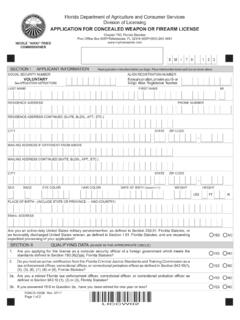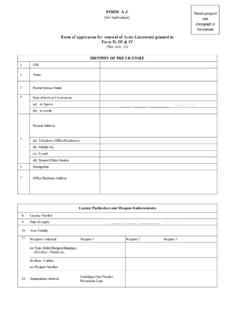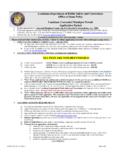Transcription of Firearms Training Manual - Florida Department of ...
1 Firearms Training Manual STUDENT HANDBOOK AND STUDY GUIDE Prepared by THE Florida Department OF AGRICULTURE AND CONSUMER SERVICES Division of Licensing FDACS P-02079 Eff. 09/2016 Rule No. , Student Handbook and Study Guide Firearms Training Manual i Introduction to the Firearms Training Manual STUDENT HANDBOOK AND STUDY GUIDE ABOUT THE Firearms Training Manual (FTM) Chapter 493, Florida Statutes, requires an applicant for a Class G Statewide Firearm license to satisfy minimum Training criteria for Firearms established by rule of the Department , which includes but is not limited to, 28 hours of range and classroom Training taught and administered by a Class K instructor.
2 Once licensed, each Class G licensee must also submit proof annually that he or she has received a minimum of 4 hours of Firearms requalification Training taught by a Class K instructor during each year of the license period. Additionally, a Class G licensee whose job duties require him or her to carry a firearm of a type and caliber different from or in addition to the firearm upon which he or she is qualified, must take a 4-hour Training class specific to that firearm s type and caliber. This Firearms Training Manual (FTM) establishes the minimum Training criteria for each course. The FTM consists of two separate but related parts: the Student Handbook and Study Guide, FDACS P- 02079, eff. 09/16 (Student Handbook), and the Instructor s Guide, FDACS P- 02078, eff. 06/16. The Student Handbook includes the essential material that each student is expected to learn: laws and rules governing Firearms ownership and possession, legal aspects of liability and use of deadly force, and mechanical operation and safe handling of a firearm.
3 The Instructor s Guide is an educational tool that will guide the instructor in conducting each course, by identifying the specific educational objectives of each lesson and providing a list of exercises and activities that will help ensure those objectives are met. Both the Student Handbook and the Instructor s Guide also include specific details concerning the course of fire that each student must successfully complete. While the FTM includes lesson material on various legal aspects of Firearms ownership, possession, and use (including liability and use of deadly force), the Firearms Training material in both the Student Handbook and Instructor s Guide are derived from the Florida Basic Recruit Training Program s High Liability Course used by the Florida Department of Law Enforcement (FDLE) and approved by FDLE's Criminal Justice Standards and Training Commission (CJSTC) for use in administering Firearms Training to basic recruits beginning their entry into the ranks of law enforcement.
4 Insofar as this Training is the accepted standard used to prepare recruits for careers in law enforcement, it is the division's position that this Training represents the benchmark of excellence with respect to Firearms Training . Therefore, it is appropriate that this Training be used to prepare security officers, private investigators, interns, and agency managers to carry Firearms while performing regulated duties. The FTM does not address every aspect of carrying a firearm by a licensed security officer or private investigator. Additional time should be taken to familiarize yourself with all of the equipment you will use while performing licensed activity - including holsters and magazine or speed loader pouches, etc. and to ensure that such equipment is compatible with your firearm. Each student should, if possible, use the holster and reloading equipment he or she will be using during regulated activities when performing the course of fire exercises contained in the Training program.
5 If you are issued or purchase new or different holsters or reloading equipment in the future, you are encouraged to spend time at a firing range in order to familiarize yourself with the equipment and its operation and security features. Student Handbook and Study Guide Firearms Training Manual ii Table of Contents Introduction .. i Table of Contents .. ii 28-Hour Initial Qualification Course Summary and Overview .. iv 4-Hour Annual Handgun Requalification/Transition Course Summary and Overview .. vii 4-Hour (Re)qualification Shotgun Course Summary and Overview .. x 4-Hour (Re)qualification Rifle Course Summary and Overview.
6 Xiii SECTION 1 LEGAL Unit 1: Legal Issues Lesson 1: Security Officer and Private Investigator Licensure .. 2 Lesson 2: Definitions and Legal Concepts .. 6 Lesson 3: Use of Force .. 11 Case Studies .. 15 SECTION 2 Firearms Training Unit 1: Firearms Safety Lesson 1: Firearms Safety Procedures .. 21 Unit 2: Firearms Familiarization Lesson 1: revolver .. 24 Lesson 2: Semiautomatic Pistol .. 26 Lesson 3: Shotgun .. 30 Lesson 4: Semiautomatic Rifle/Carbine .. 33 Unit 3: Ammunition Use Lesson 1: Ammunition Identification and Maintenance .. 36 Unit 4: Fundamentals of Marksmanship Lesson 1: Handgun .. 40 Lesson 2: Shotgun .. 49 Lesson 3: Semiautomatic Rifle/Carbine .. 52 Unit 5: Drawing and Holstering a Handgun Lesson 1: Drawing and Holstering a Handgun .. 56 Unit 6: Loading and Unloading Lesson 1: revolver .. 57 Lesson 2: Semiautomatic Pistol.
7 60 Student Handbook and Study Guide Firearms Training Manual iii Lesson 3: Shotgun .. 62 Lesson 4: Semiautomatic Rifle/Carbine .. 64 Unit 7: Use of Cover Lesson 1: Use of Cover .. 65 Unit 8: Weapons Malfunctions Lesson 1: revolver Malfunctions .. 68 Lesson 2: Semiautomatic Pistol Malfunctions .. 70 Lesson 3: Shotgun Malfunctions .. 73 Lesson 4: Semiautomatic Rifle/Carbine Malfunctions .. 75 Unit 9: Weapon Cleaning Lesson 1: revolver Cleaning .. 78 Lesson 2: Semiautomatic Pistol Cleaning .. 80 Lesson 3: Shotgun Cleaning .. 83 Lesson 4: Semiautomatic Rifle/Carbine Cleaning .. 85 Unit 10: Survival Shooting Lesson 1: Handgun.
8 87 Lesson 2: Discretionary Shooting .. 89 Appendices Appendix A: Courses of Fire .. 92 Appendix B: Shooting Targets .. 105 Appendix C: Case Study Answers .. 106 Appendix D: 110 Student Handbook and Study Guide Firearms Training Manual iv 28-HOUR INITIAL QUALIFICATION COURSE SUMMARY AND OVERVIEW Course Description In order to obtain a Class G Statewide Firearm license , each applicant must successfully complete the 28-hour initial qualification course. This course provides students with the basic knowledge and proficiency skills needed to safely handle and shoot a handgun ( revolver or semiautomatic pistol).
9 Along with extensive educational material on Firearms safety and the mechanical operation of Firearms , this course also includes material on various legal aspects of Firearms ownership, possession, and use. At the conclusion of the classroom portion of the 28-hour course, an examination will be administered to test the student s mastery of content. Finally, students will be required to demonstrate proficiency in shooting a handgun by passing the course of fire outlined in this Training Manual . Course Expectations Upon the completion of this course, the student should be able to demonstrate the following skills and techniques: Identify the legal authority allowing security officers and private investigators to carry a firearm Identify the limitations of a security officer s ability to carry a firearm and use deadly force Identify crimes that may serve as a justification for the use of deadly force Identify the types of liability that may result from the improper use of a firearm Safe weapon handling Identification of weapons parts and ammunition Weapons cleaning and maintenance Handgun drawing and holstering Weapon loading and unloading Basic shooting principles Proficiency with a firearm by shooting a qualifying score with a handgun ( revolver or semi-automatic pistol)
10 Proficiency for weapon handling Proper intervention for weapon malfunctions Course Requirements Each student is responsible for reading and reviewing all course-related material. Your instructor will discuss general rules of Firearms safety, and you will be expected to strictly abide by these rules throughout the entirety of this course. You will be required to attend classroom lectures that include the topics listed below. Upon completion of the classroom portion, you must complete a written examination that covers all of the course content, and pass the exam with a minimum score of 70%. You will then meet at a firing range facility to perform practical exercises using the type and caliber of handgun with which you intend to qualify. Students are required to show a minimum proficiency Student Handbook and Study Guide Firearms Training Manual v of 70% on the basic Firearms course of fire.






